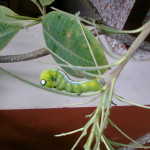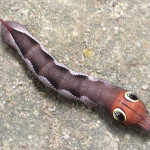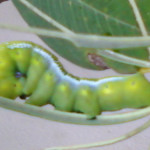Nettle Caterpillar (Parasa lepida)
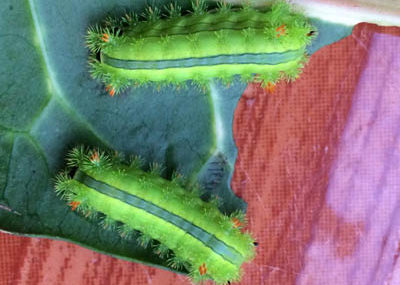 Last Observed: March 2016 – Koh Chang
Last Observed: March 2016 – Koh Chang
Last Observed By: Hans Henrik Hansen
The nettle caterpillar is a bright green caterpillar with a dark green stripe that eventually devlops into a brown and green moth.
It’s larvae are considered to be pests and pose a threat to various crops such as coffee, coconut, cocoa, tea nad mango.
Nettle Caterpillar Wikipedia
Micronia Aculeata
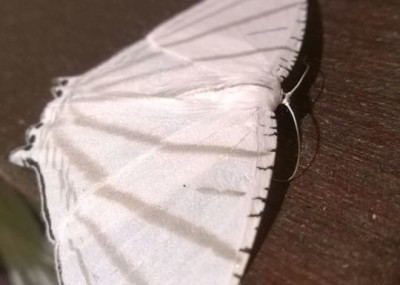
Image Copyright Napha Kotkangplu
Last Observed: February 2016, Koh Chang
Observed By: Napha Kotkangplu
Okay let’s be honest here. This moth might not actually be micronia aculeata, a moth that is apparently found in India and Sri Lanka. Hard to tell though, it certainly looks extremely similar so at worst it’s a very close relative. And the internet has so much different and often contradictory information that identifying animals – particularly insects – extra particularly butterflies and moths is a nightmare. So it’s Micronia aculeata until an expert tells us otherwise. Okay?
Micronia Aculeata Wikipedia
Common Earl
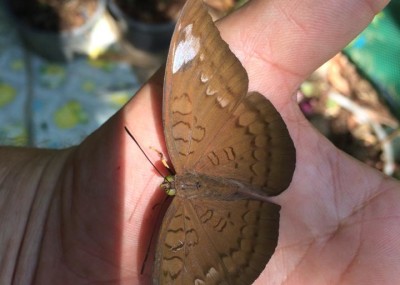
Image Copyright Hans Henrik Hansen
Last Observed: February 2016
Observed By: Hans Henrik Hansen
Butterflies get some strange names. Naming one the Common Earl suggests that there should be a rare earl or something out there that is altogether more exotic.
The Common Earl is a species of nymphalid butterfly native, even common, to South and Southeast Asia.
Common Earl Wikipedia
Clethyrogna Turbata
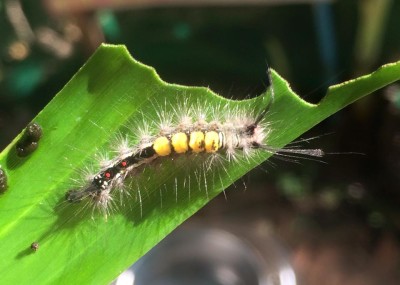
Image Copyright Hans Henrik Hansen
Observed: Koh Chang, December 2015
Observed By: สุธนัย ครุพานิช
The adult form of this moth species is a comparatively drab reddish brown colour but the caterpillar, as you can see, more than makes up for this by being a furry explosion of red, yellow and black.
Clethyrogna Turbata Project Noah
Colour Sergeant (Athyma nefte)
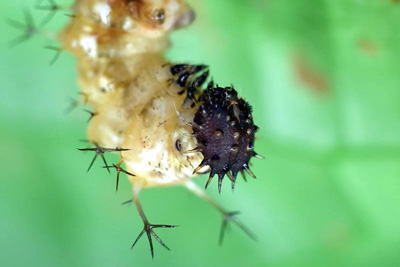
Image Copyright สุธนัย ครุพานิช
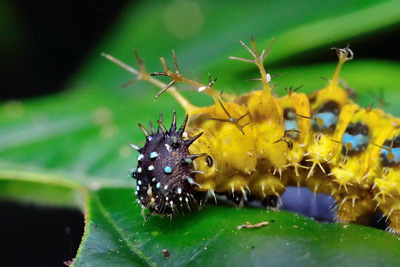
Image Copyright สุธนัย ครุพานิช
Observed: Koh Chang, December 2015
Observed By: สุธนัย ครุพานิช
The colour sergeant is a species of brush-footed butterfly with black wings that have a white and an orange stripe. You can’t see that here though since we only have observations of the weid and worderful juvenile caterpillar form.
As you can see this is a many-horned and spiky little creature that exudes all kinds of tendrils and feelers.
Colour Sergeant Wikipedia
King Crow (Euploea phaenareta)
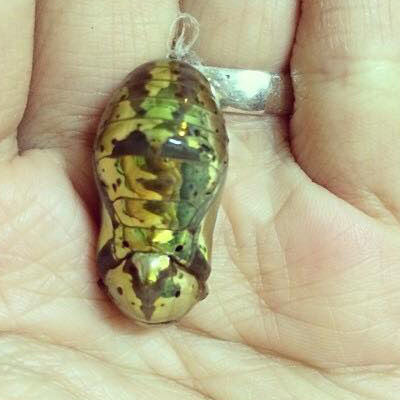
Image Copyright Loukpud Shinkhem
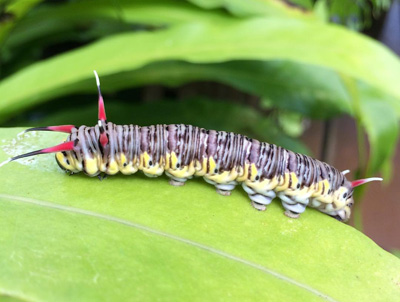
Image Copyright Loukpud Shinkhem
2015, Koh Chang
Observed By: Loukpud Shunkhem,
The King Crow is a butterfly with an amazing life cycle. It’s appearance changes constantly through its caterpillar stage culminating in the weird and striking final stage pictured.
Then the caterpillar turns into a pupa of a striking shiny gold colour.
And so when it emerges as a butterfly it is… brown-winged with white spots – a very respectable looking insect but not quite as bright as you would have expected.
There’s an excellent write up below.
King Crow Life History at Butterflycircle
A note on Instars
I keep reading about instars in relation to insect growth. Here’s what they are. Insects develop through a series of stages known as instars. Each instar usually culminates in the shedding of a layer of skin, and often, as in the case of the King Crow – by very dramatic changes in appearance.
Eastern Tent Caterpillar (Malacasoma americanum)
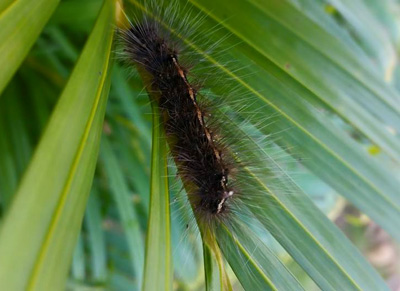
Image Copyright Rinske Hackman
Observed: November 2015
Observed By: Rinske Hackman
The Eastern tent caterpillar is the juvenile form of the the lappet moth. It is covered in immensely long hairs that serve as protection from predators.
Upon hatching thes ecaterpillars gather together under a tent that they weave out of silk until they have grown to a stage where they can progress alone.
The Wikipedia entry is particularly informative about pretty much everything you could ever think of to ask about this animal.
Eastern tent caterpillar Wikipedia
Artena Convergens
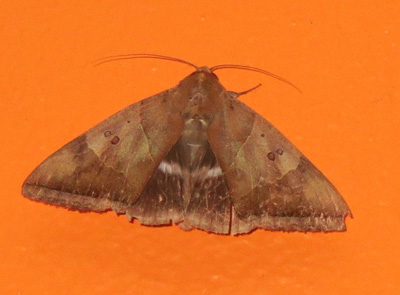
Image: Dave Hinchliffe
Observed: November 2015
Observed By: Dave Hinchliffe
Information is a little scarce on Artena convergens. Wikipedia is unusually reticent and it doesn’t seem to have been given a common name, poor thing. It’s quite a pretty moth as well, subtle colours, but attractive. Anyway it’s a moth of the Noctuidae family that has been spotted on Koh Chang, more specifically on my kitchen wall.
Artena Convergens Wikipedia
Oleander Hawk Moth (Daphnis nerii)
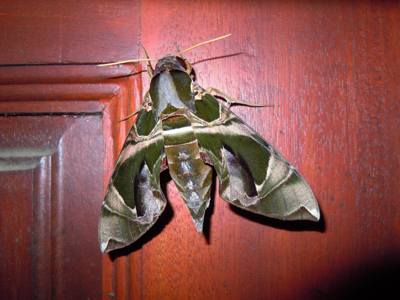
Image Copyright Tijl Adriaen
Last Observed: November 2015
Observed By: Tijl Adriaen, Dave Hinchliffe
The Oleander Hawk Moth is striking as a caterpillar and has a beautiful adult form as well.
The caterpillar has very large false eye colours to mislead predators.
The moth feeds largely on the highly toxic oleander plant, to which it is immune. When it can’t feed Oleander it thrives on plants from a family called Dogbane, you’d have to assume they were toxic too.
Daphnis Nerii Wikipedia
Image Copyright Dave Hinchliffe
Image Copyright Dave Hinchliffe
Image Copyright Dave Hinchliffe
Dasychira Horsfieldi
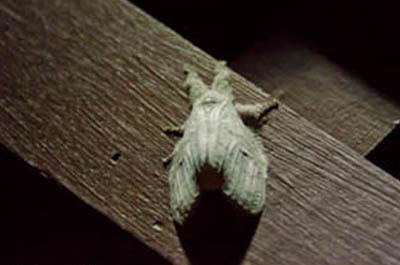
Image Copyright David Vinot
Last Observed: February 2015
Observed By: David Vinot
Dasychira Horsfieldi is a small moth named after a chap called Horsfield. And that’s about all we can tell you.
 Last Observed: March 2016 – Koh Chang
Last Observed: March 2016 – Koh Chang










